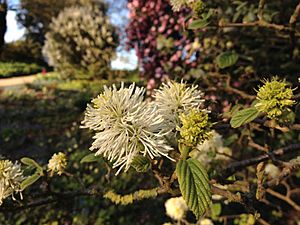Dwarf witchalder facts for kids
Quick facts for kids Dwarf witchalder |
|
|---|---|
 |
|
| Scientific classification | |
| Genus: |
Fothergilla
|
| Species: |
gardenii
|
The Fothergilla gardenii, often called dwarf fothergilla or witch alder, is a special kind of plant. It's a deciduous shrub, which means it loses its leaves every autumn. This plant belongs to the Hamamelidaceae family, which also includes witch hazels. It's one of only two types of plants in the Fothergilla group.
Contents
What is Fothergilla Gardenii?
This plant is a slow-growing shrub. It usually grows to be about 0.9 to 1 meter (3 feet) tall and wide. It's a great size for many gardens!
What Do Its Leaves Look Like?
The leaves of the dwarf fothergilla are dark green. They grow in a pattern where each leaf comes out on a different side of the stem. They can be oval or egg-shaped and grow up to 6 centimeters (2.5 inches) long. The edges of the leaves are a bit jagged.
In autumn, these leaves put on a spectacular show! They turn bright red, deep crimson, orange, and yellow. It's like a rainbow in your garden.
What About Its Flowers?
In spring, before the leaves even fully appear, the dwarf fothergilla grows unique flowers. They form in spikes that look like little brushes, about 4 centimeters (1.5 inches) long.
The flowers themselves are small and white, and they don't have petals. But they are very fragrant, meaning they smell wonderful! You'll notice their long, showy stamens, which are like tiny threads sticking out, about 2.5 centimeters (1 inch) long.
Where Does Fothergilla Gardenii Grow?
This plant is native to the southeastern parts of the United States. You can find it growing naturally from North Carolina all the way down to Alabama.
How to Grow Fothergilla Gardenii
The dwarf fothergilla is a tough plant! It can handle cold temperatures down to -29 degrees Celsius (-20 degrees Fahrenheit). Gardeners often refer to this as USDA zones 5-9.
What Does It Need to Grow Well?
This plant likes to grow in a spot that gets lots of sun or a little bit of shade. It prefers soil that is rich in humus (decayed plant matter) and drains water well, but still stays moist. If you want the best autumn leaf colors, give it full sun! It's a great choice for woodland gardens or along the edges of shrub beds.
How Can You Make More Fothergilla Plants?
There are a few ways to grow new dwarf fothergilla plants:
Growing from Seed
You can plant seeds outdoors in a special cold frame or seedbed during autumn or winter. The seeds usually sprout in the second spring after you plant them. Fresh seeds work best!
Growing from Cuttings
Another way is to take "softwood cuttings" in summer. These are new, soft stems. You can root them in a mist unit, which keeps them moist.
Growing by Layering
Layering is a cool way to grow new plants from a parent plant without cutting them off right away.
- Air Layering: This involves wrapping a part of the stem with moist material while it's still on the plant. Roots will grow there, and then you can cut it off.
- Simple Layering: You can bend a low-hanging branch down to the ground, cover part of it with soil, and let it root while still attached to the main plant.
Does It Get Pests or Diseases?
Good news! The dwarf fothergilla is usually very healthy and doesn't have many problems with pests or diseases.
Special Types of Fothergilla Gardenii
There's a special type of dwarf fothergilla called Blue Mist. People grow it because its leaves have a pretty blue-green color, which is quite unique!
Why is it Called Fothergilla Gardenii?
The name Fothergilla honors Dr. John Fothergill (1712-1780). He was a doctor from England who helped bring many American plants to Europe.
The second part of the name, gardenii, is named after Dr. Alexander Garden (1730-1791). He was a botanist (someone who studies plants) from America who wrote letters to the famous scientist Carl Linnaeus.
See also
 In Spanish: Fothergilla gardenii para niños
In Spanish: Fothergilla gardenii para niños


